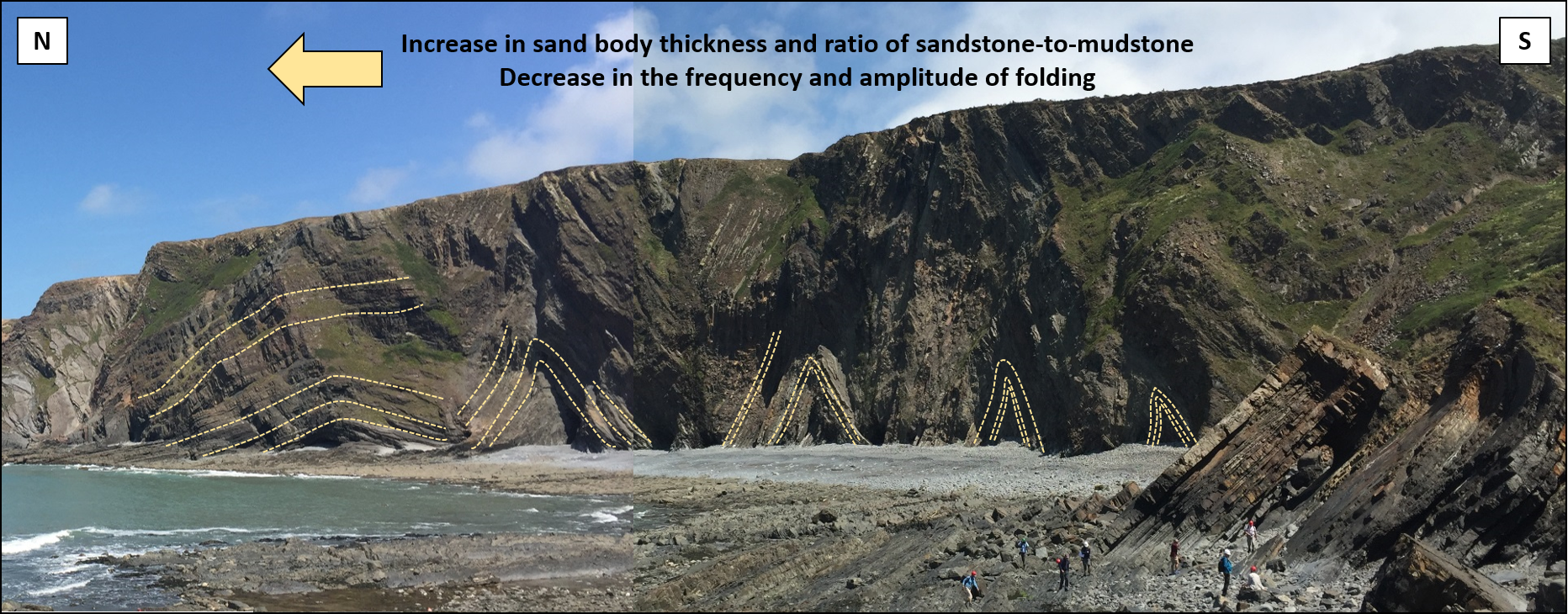REVIEW: Structural Geology Field Trip to Bude, North Cornwall

Review by Alastair Burke
Geologically this region is characterised by the presence of Late Carboniferous turbidites that have been heavily folded and faulted by the Late Palaeozoic Variscan collisional orogeny.
The overall theme of this field trip was to examine and demonstrate the relationship and interplay between structure geometry and stratigraphy (in this case variations in the ratio of Sandstone to Mudstone), something that is collectively termed ‘Mechanical Stratigraphy’.
Our first location was Hartland Quay, North of Bude. The weather, rather unusually for a UK based field trip, was fantastic. Our course tutor, Jonathan Turner (a Structural Geologist with BG-Group) gave us an overview of the area (a series of heavily folded turbidites) which at points we struggled to hear due to a rather noisy pair of nesting Peregrine falcons! This area was where John Ramsey, the ‘Father’ of modern structural geology, worked on and devised his theory on the mechanics of chevron folding back in 1974. The quality of the exposure is second to none. The locality demonstrates everything from the small scale deformational features (at individual fold level) through to large scale where a change in the thickness of the sand bodies alters the style of folding from tight chevron to broad low amplitude anticlines.
The second location of the day was Millook Haven, to the South of Bude. This area further demonstrates how changes in the stratigraphy (in this case a series of tabular and evenly bedded turbidites) influenced the style of deformation, expressed as a series of sharp crested and recumbent chevron folds.
Additionally, we saw evidence of how, during the early stages of diagenesis, mudstones and sandstones can respond differently to strain. What we saw was the apparent flow from the mudstone interval into tension cracks developing within the sandstones intervals.
At the end of the day we returned to Bude and reassembled that evening on the beach for a civilised dinner of fish and chips, pizza and wine!
On Day 2 the weather had returned to familiar conditions for a UK based field trip – wind and near horizontal rain! Not to be deterred from our mission, however, and remaining as enthusiastic as ever, Jonathan lead us on a short walk down to Bude beach to the first stop; an exhumed plunging anticline known as the ‘Whaleback’.
The ‘Whaleback’ allowed us to examine in three dimensions the complexity, variation and seemingly conflicting coexistence and expression of both compressional forces (in the form of pressure solution) and tensional forces (expressed as filled fractures) during the generation of the structure. We also saw wonderfully preserved examples of centimetre scale syn-depositional faulting within the mudstone units.
At Upton, South of Bude, we again observed the influence that changes in the ratio of Sand to Mudstone have on the deformation style. In this example, relatively thick channel sands limit the deformational style to a low amplitude anticline with further additional compression accommodated by the formation of thrust related duplexes.
Our final location, Crackington Haven, demonstrated the opposite of what we had seen previously at Upton where thin bedding led to the development of near isoclinal folding.
Thanks must go to Jonathan Turner, the course tutor, for his guidance and expertise during the trip. Jonathan managed to blend and deliver perfectly his academic and industry experience providing what was a very interesting and relevant field trip.
For me personally as an Interpreter/Geophysicist the two key messages that I took away from the field trip were; firstly, how complex and three dimensional these deformational processes actually are and secondly, a firm reminder that when I am at my workstation looking at data it is equally important to have an appreciation not only of what you do see, but also what you don’t see!


